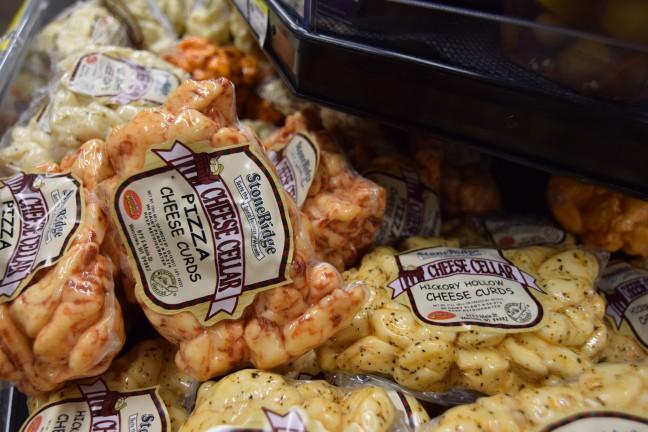The Catalysts for Science Policy organization plans to introduce a bill aimed at adopting Lactococcus lactis as Wisconsin’s state microbe. Affiliated with the University of Wisconsin, CaSP’s goal is to educate and bring awareness about scientific policy to non-graduate and graduate students alike, which they aim to do with this new bill.
Considering the state of Wisconsin is the leading producer of cheese in the country, according to Statista, L. lactis is a heavy contributor to Wisconsin’s success. Due to this, CaSP has advocated for its adoption as the state microbe, according to CaSP’s website.
“Having a state microbe would provide an opportunity not only for students to learn about the cheesemaking process — something that is culturally very important to Wisconsin — but also to learn a little bit about microbiology. We want people to understand that there are beneficial microbes, that a lot of the things we enjoy in life are dependent upon microbes and that they do really good things for us,” CaSP Co-President Christopher Dade said.
Unlike a state bird, rock or flower, a few states have chosen to adopt a state microbe. According to CaSP’s issue brief, only three states have passed a state microbe into law — Oregon signed Saccharomyces cerevisiae, New Jersey signed Streptomyces griseus and Illinois signed Penicillium rubens. Hawaii has a proposed state microbe, Aliivibrio fischeri, but it has yet to pass much like in Wisconsin.
While Wisconsin attempted to pass L. lactis as the state microbe in 2009, it did not pass through the Senate, Dade said. But now that other states have adopted the idea of a state microbe, the path for L. lactis may be easier this time around. According to Dade, there is high hope for the bill’s success.
According to ScienceDirect, L. lactis is a part of the mesophilic bacteria group, meaning it prefers moderate temperatures, and is a crucial component for the production of dairy products.
“In effect, without this bacteria [L. lactis], we could not make a majority of the cheeses in Wisconsin which the state is known for and a large producer of,” Dade said. “In addition, Wisconsin is the largest producer of cheese cultures … so Wisconsin not only makes the cheese, but Wisconsin mass produces the bacteria to help other people make cheese as well.”
CaSP member Austin Hall said one of the main reasons L. lactis has been proposed to represent Wisconsin is its crucial role in the cheesemaking process. Cheesemakers will add the bacterium into pasteurized milk, and it will produce an acid that catalyzes, or speeds up, the curdling process. These curds are finally separated, shaped and aged in a way specific to the type of cheese being produced.
This simple yet significant technique is used throughout the state for not only the development of cheese but also for the insurance of food quality, Hall said.
“Changing the acidity of foods typically can protect against other harmful pathogens from colonizing or changing the food,” Hall said. “L. lactis also produces a chemical called niacin. It’s a natural food preservative that a lot of other microorganisms don’t like, so they can’t grow as well.”
UW professors awarded grant for life sciences communication research
The adoption of L. lactis as the state microbe is intended to honor the history and economic value of cheesemaking in Wisconsin, according to a CaSP poster. As a part of Wisconsin law, all state symbols are taught in school, which would then bring awareness to the two key figures of Wisconsin’s cheese-making history — Charles Rockwell and Anne Picket.
Beginning in the mid-1800s, Charles Rockwell produced cheese from the Fort Atkinson area, and Anne Picket began the first cottage industry cheese farm in 1841, according to the poster. Ultimately, their success sparked Wisconsin’s economic and cultural relationship with cheese.
As time progressed, the amount of demand for cheese increased, so factories dedicated to producing cheese were formed. Immigration helped introduce other forms of cheese into Wisconsin’s cheese production. Ultimately, the popularity of cheese only increased and is still a major part of Wisconsin today, especially the economy, according to the poster.
Agricultural practices in Wisconsin account for 11.8% of the state’s employment, contributing $104.8 billion to the state economy, according to CaSP’s issue brief. Of that $104.8 billion, the dairy industry contributes approximately half. Another big contributor to Wisconsin’s economy rests in the distribution of cheese cultures.
CaSP has distributed its memo detailing its proposal to acquire co-sponsors that may support the bill, Dade said. Depending on the speed of the legislative cycle, the members of the organization hope this bill will be introduced officially by the end of November or early December so the public gains an awareness of this unique microbe.
“The early signs that we’ve seen show that we have bipartisan support in both the Assembly and the Senate to get the ball rolling,” Dade said. “We think we could build a coalition if the legislation moves forward.”


















